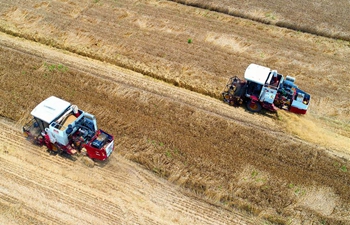HOUSTON, June 4 (Xinhua) -- A newly developed fertilizer system may provide nutrition to engineered cotton crops, while suppressing weeds that are increasingly herbicide resistant, according to a public release by U.S. Texas A&M AgriLife Communications on Monday.
According to the Texas A&M AgriLife Research study, the new system applies phosphite to cotton crops engineered to express a certain gene -- a gene that makes cotton able to process the phosphite into nutrition while the same compound suppresses weeds that are unable to use it.
"Our researchers here at Texas A&M AgriLife have addressed an issue that costs producers billions of dollars," said Patrick Stover, vice chancellor of agriculture and life sciences at Texas A&M in College Station, about 160 km northwest of downtown Houston."
Stover, also acting director of Texas A&M AgriLife Research, said, "This is an economical, environmentally safe and sustainable solution."
He said this is an exciting and timely discovery in the movement to get ahead of the ongoing problem of weeds evolving faster than the chemicals and other methods developed to control them.
"We believe the ptxD/phosphite system we have developed is one of the most promising technologies of recent times that can help solve many of the biotechnological, agricultural and environmental problems we encounter," said Keerti Rathore, an AgriLife Research plant biotechnologist.
Phosphorus is a major element required by all living beings - life is not possible without it. Most organisms can only utilize phosphorus in the form of orthophosphate.
"We have determined ptxD-expressing cotton plants can utilize phosphite as a sole source of phosphorus while weeds cannot, thus making it effective at suppressing weed growth," Rathore said.
Weeds typically are managed manually, mechanically or chemically. However, he said, chemical control options are rapidly shrinking due to an increasing number of herbicide-resistant weeds in crop fields, with few alternatives on the horizon.
Rathore, who has been researching genetic improvement of cotton for more than 20 years, said herbicide-resistance in weeds is not just a U.S. problem, but rather a global challenge for producers of cotton, corn and soybeans.
Such a development will also relieve some of the negative perceptions associated with the use of herbicide-resistance genes and heavy dependence on herbicides, he said.
Rathore has also developed cotton plants that produce very low levels of gossypol in the seeds to improve the safety and nutrition aspects of the cotton seed, but simultaneously maintain normal levels of this chemical in the foliage, floral parts, boll rind and roots for protection against insects and pathogens.
Future studies will focus on testing ptxD-transformants in the fields that are low in phosphorus as well as evaluating the utility of phosphite as an over-the-top 'herbicide,' Rathore said. Also, long-term impact of the use of phosphite as a source of phosphorus on the soil microflora under field conditions needs to be investigated.
Texas A&M University opened its doors in 1876 as the state's first public institution of higher learning. Located in the heart of the Houston-Dallas-Austin triangle, within a two-hour drive of 26 million of the state' s 28 million residents, Texas A&M's main campus in College Station is home to more than 62,500 students. Another 5,700 are at the branch campuses across the State of Texas.

















